P2835
Roses in Mississippi: The Allure, Lore, and History of Roses
The rose is one of the most popular flowering plants in the world. Its beauty, fragrance, and diversity provide value beyond our physical needs. That is why gardeners give prominent space to roses in their gardens and spend time, labor, and money to have roses in their lives. And gardeners challenge themselves not only to grow roses but to grow them better than their neighbors. We humans are very interesting creatures.
Rose species are native to the northern hemisphere, from eastern Asia to western North America. The beginnings of rose domestication are unclear, but it is likely that centers of cultivation began in early Chinese, Persian, Greek, and Roman cultures. Travel and trade among regions surely included the barter of valuable roses. The establishment of rose gardens led to natural and experimental crosses between the roses of the East and the West. Garden roses were diversified well before they came to North America.
These roses followed human migration westward, and some of their progeny now live alongside native species and on old homestead sites and in cemeteries.
In other words, trading and business have always been at the heart of garden rose development. The wealthy sent out plant explorers to search for exotic plants for beauty and commerce. Breeders and growers of roses produced plants that met aristocrats’ and tycoons’ plant needs and obsessions.
Today, breeders continue to define rose perfection. Often they promote one characteristic to the detriment of others. Many cultivars that are front-page headlines today will disappear within a year or two of dismal performance. But good roses endure and thrive. That is why old garden roses do so well: they are the survivors. The same will happen with modern roses. Gardeners will continue to select roses that grow well and make people happy.
Considering adding roses to your garden? Here are some tips for success:
- Choose a planting location. Roses should receive a minimum of 6 hours of direct sunlight daily. Be sure the soil is fertile and well-drained.
- Select cultivars or species that thrive in the climate and soil conditions you have and that can resist pests and diseases that are common to your site conditions.
- Decide how much time and effort you are willing to invest in controlling disease before making your rose choices. Select cultivars and species based on your time and effort commitment.
- Decide if you are comfortable using chemicals or prefer to use an organic approach to growing roses before choosing which roses to grow. Select cultivars and species based on your maintenance direction.
- Buy vigorous, healthy plants from a reliable source. Cultivate plants using proper pruning, mulching, watering, and fertilization practices.
Getting to Know Your Roses
Roses are grouped into classes to make sense of the great diversity of known cultivars. Groupings are subjective, and major rose societies sometimes group cultivars differently. The following list describes some commonly accepted groupings. Not all classes of roses grow well in the Southeast. Those classes will be noted in their description where they are listed.
Species and Old Garden Rose Classes: Prior to 1867
Species roses are the basis on which the garden rose is developed. Knowing where these species come from helps us to understand where genetic tolerance to heat and cold come from, as well as various plant characteristics. They fall into four basic geographic groups. Not all rose species are listed, just those often genetically important to commercial or garden rose development.
Asian species
Southern Asia
- R. chinensis
- R. laevigata
- R. bracteata
- R. banksiae
- R. multiflora
- R. wichuraiana
- R. brunonii
- R. filipes
- R. moyesii
Northern Asia
- R. rugosa
Middle Eastern species
- R. foetida (R. foetida and its forms are important breeding roses for yellow flower color and thought to carry genetic susceptibility to blackspot.)
- R. hemisphaerica
- R. x damascena (R. x damascena and its forms are an important source of attar of roses.)
- R. x centifolia
European species
Northern Europe
- R. canina (dog rose)
- R. eglanteria (sweetbriar rose)
- R. villosa (apple rose)
- R. pimpinellifolia (Scotch rose)
- R. arvensis (field rose)
Central and Eastern Europe
- R. gallica
Southern Europe and the Mediterranean
- R. moschata
American species did not directly contribute to the development of old garden rose classes. However, R. virginiana, R. carolina, and R. palustris (swamp rose) are garden plants in their own right. Other species exist but are found outside the Southeast.
Climbing species roses are distinct and have their own groups of hybrids. Banksian roses are a small group originating from China. They were introduced into the Southeast in the early 19th century. ‘Lady Banks Rose’ (R. banksiae lutea) is the most widely seen rose of this group in Mississippi. Banksian roses are very large climbers that are semi-evergreen and thornless.
Gallica roses (‘Rose of Provins’) are an ancient group of roses derived from R. gallica, native to central and southern Europe. They are thought to have been grown by ancient Greeks and Romans and possibly earlier. The shrub is upright in growth habit, about 3 to 4 feet tall, is freely suckering, and has many small, bristly thorns. Flowers are pink, 2 to 3 inches in diameter, highly fragrant, and followed by round, red hips. Foliage is rough, dark green, and oval.
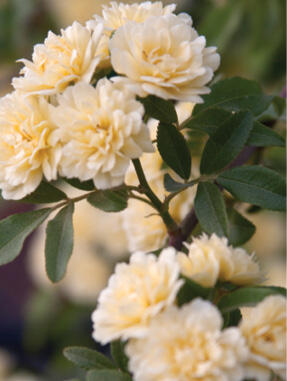
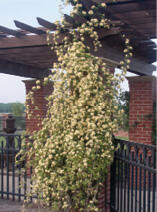
Lady Banks Rose
Damask roses were brought back to Europe by returning crusaders in the 12th and 13th centuries and found to be hardy in northern gardens. They are an ancient rose group thought to originate with the Persians from a cross between a Gallica rose and R. phoenicea. The petals were used to make perfume. ‘Autumn Damask’ is the only cultivar to bloom twice a year, with references dating back to Greek and Roman cultures. ‘Kazanlik’ is the only Damask rose grown in the Veterans Memorial Rose Garden, and its natural growth habit is coarse and wild. The foliage is gray, downy, and soft to the touch. The rest of the plant is highly thorny and difficult to handle. Its flower fragrance is not strong in our climate.
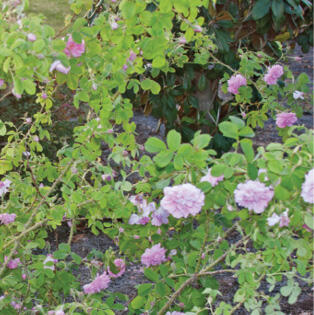
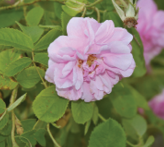
Kazanlik
Alba roses are an ancient group of roses thought to be a cross between a Damask or Gallica rose and R. canina. They may have been brought to Britain by the Romans, and they appear in paintings from the Middle Ages. These are tough, large rose shrubs, 6 feet or more, with mounding growth habit and soft, gray-green foliage. Flowers are delicate white, blush, or pink, and mostly fragrant. ‘Madame Plantier’ is an Alba/Noisette hybrid that thrives in the Veterans Memorial Rose Garden.
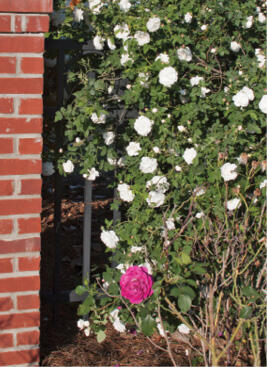
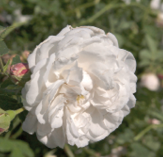
Madame Plantier
Centifolia (Provence) roses, based on R. x centifolia and its hybrids, were developed by Dutch breeders in the 15th and 16th centuries, possibly later. They have an awkward growth habit; coarse, dark-green foliage prone to powdery mildew; and many thorns. The flowers are highly double, pink, fragrant, and cabbage-like in form. Centifolia roses are not recommended as being sufficiently heat-tolerant for the Veterans Memorial Rose Garden.
Moss roses apparently developed as a sport of a Centifolia rose in the early 18th century. They are known for their highly developed prickles, found on the stems, foliage, flower buds, and hips. These prickles may be soft or bristly. ‘Henri Martin’ is reportedly more heat-tolerant than other moss roses.
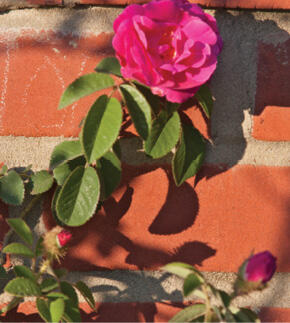
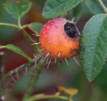
Henri Martin
China roses are different from the earliest types of roses because they flower in repeating cycles. Early China roses are thought to have developed from R. chinensis and R. gigantea. Roses of hybrid form are documented in artifacts dating to the 10th century, with European introduction in the late 18th century from trade by the British East India Company. The shrubby growth habit is airy, with slender, twiggy growth and few thorns. Foliage is sparse, with pointed leaves and a shiny surface. New growth is often red on both the leaves and stems. Blooms are casual in form and intensify in color as they age. Growth is stronger and larger in warm climates. ‘Comtesse du Cayla’, ‘Cramoisi Supérieur’, and ‘Mutabilis’ are China roses grown in the Veterans Memorial Rose Garden. ‘Climbing Cécile Brünner’ is considered either a China or a Polyantha rose, depending on source.
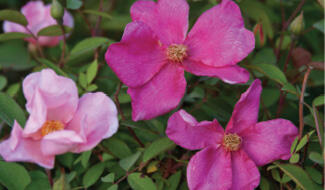
Mutabilis
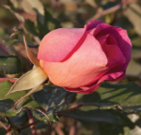
Comtesse du Calya
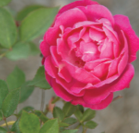
Cramoisi Supérieur
Portland roses developed in France in the late 18th century. They are thought to have Damask, Gallica, and possibly China parentage. They are small, upright shrubs with a strong Damask resemblance, repeat flowering, and Damask fragrance. Flower stems are short, with a tight cluster of leaves just below the bloom. ‘Rose de Rescht’ is reportedly more heat-tolerant than other Portland roses.
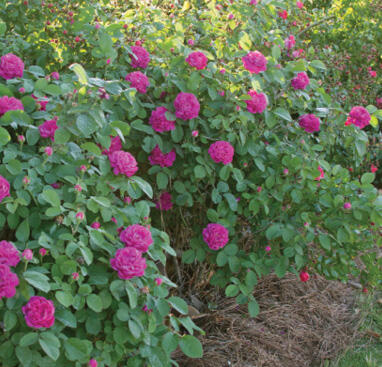
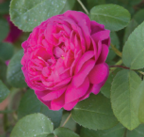
Rose de Rescht
Bourbon roses came from a chance cross between the China ‘Old Blush’ and the Damask ‘Quatre Saisons’ (syn. ‘Autumn Damask’) on the Ile de Bourbon in the southern Indian Ocean in the late 18th century to the early 19th century. They represent a transition phase between old garden roses and modern roses. The flowers are like old roses, and the growth form is shrubby. However, the foliage and stems look more like a hybrid tea, and the roses bloom in repeating cycles. ‘Louise Odier’ and ‘Kronprinzessin Viktoria’ represent this class in the Veterans Memorial Rose Garden.
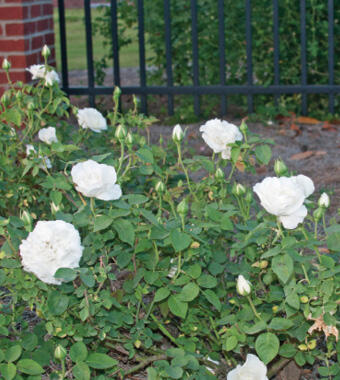
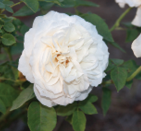
Kronprinzessin Viktoria
Noisette roses arose in Charleston, South Carolina, in the late 18th century, when John Champneys, a rice grower, collected seeds from a crossing between the China ‘Old Blush’ and R. moschata. His neighbor, Phillipe Noisette, continued crossing these seedlings and sent them back to France. Many of these are large climbers with continuous flowering through the growing season. Their growth is refined and delicate, with fragrant old rose- style blooms. They are less hardy than other classes but do well in the warm Southeast. ‘Céline Forestier’ represents this class in the Veterans Memorial Rose Garden.
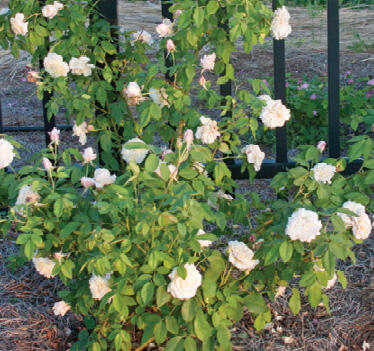
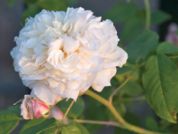
Céline Forestier
Tea roses developed in China about the same time as the hybrid perpetual roses in the early 19th century. They developed from a cross between ‘Hume’s Blush China’ and ‘Park’s Yellow Tea Scented China’. The early tea roses were part of an active breeding program in China at the time the East India Company exported much tea to Great Britain. The story is that these roses were named for their tea-like fragrance, but it is just as plausible that they acquired the name because they were often shipped with tea. Yellow flowers came from this breeding program, and tea roses became a parent of the hybrid tea class. Tea roses developed a high-centered bud form that was carried into the hybrid teas, but the growth habit is twiggy and airy, and the floral stems are slender and weak like China roses. Tea roses prefer a warmer climate than England’s, where it developed as a hot-house plant. ‘Duchesse de Brabant’ is a tea rose in the Veterans Memorial Rose Garden.
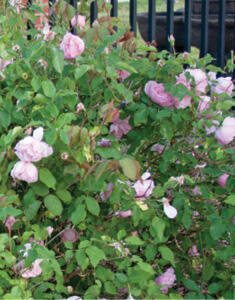
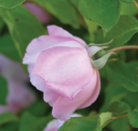
Duchesse de Brabant
Hybrid perpetual roses were first recognized in the 1820s. They were bred for rose shows where bloom form, especially the bud, was considered the ultimate ideal. The growth habit tends to be large, narrow, and upright to sprawling. The flowers are large and less refined than hybrid teas. They may become large, vigorous bushes if given good cultural care and pruning. Hybrid perpetual roses were historically relegated to cutting gardens. Most of them are fragrant and repeat blooming, and have an old rose flower form. ‘Ferdinand Pichard’ is the only hybrid perpetual growing in the Veterans Memorial Rose Garden.
Pimpinellifolia (Scotch, Spinosissima) roses are a small group that grow well on their own roots and sucker freely. They are easy to grow and reproduce. An American cultivar, ‘Harison’s Yellow’, became The Yellow Rose of Texas and spread west with homesteaders.
Climbing roses are often formed from sports of existing cultivars that produce long canes requiring some support. Old garden rose and modern rose climbers may develop from either sports or seedlings. Climbers are often trained on trellises, pillars, or fences, or draped over banks or retaining walls. They are hardy plants and may become popular in their own right compared to the original shrub. Old garden rose climbers are grouped into several accepted classes, such as Climbing Bourbon, Climbing China, Climbing Moss, and Climbing Hybrid Perpetual.
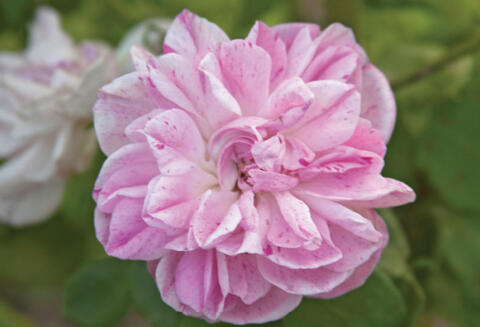
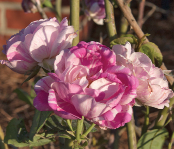
Ferdinand Pichard
Modern Rose Classes: From 1867
Hybrid tea roses generally grow as a narrow, upright shrub well suited for formal gardens. The flowers are usually double with spiraling petals around a high center, a “typical” rose bloom form. Single blooms develop at the end of a long stem, which is prized for cut flowers. Blooms may or may not be fragrant, and they repeat in cycles throughout the growing season. Hybrid tea rose cultivars have been introduced since 1867. For example, ‘La France’ is considered the beginning of modern classes of roses. ‘Elina’ and ‘Jane Pauley’ are two examples of hybrid tea roses.
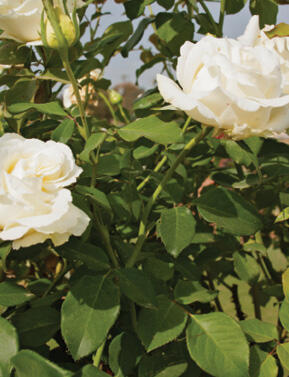
Elina
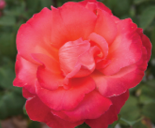
Jane Pauley
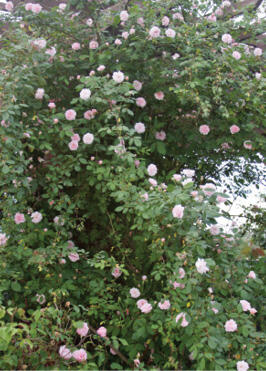
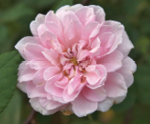
Climbing Cécile Brünner
Hybrid Musk roses are another early modern group of shrubby roses, based on a rambler called ‘Trier’ and different Noisette, Polyantha, hybrid tea, and tea roses. They are large shrubs with a graceful form and sprays of small to medium size flowers of soft colors. With good care, they rebloom well, providing masses of floral display. The growth habit has a classic feel to it with modern-style foliage of smooth, shiny leaves. ‘Buff Beauty’ is a hybrid musk grown in the Veterans Memorial Rose Garden.
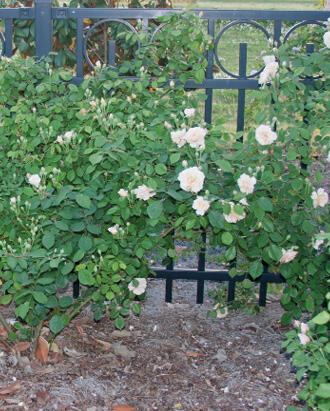
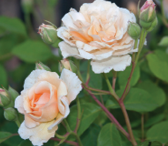
Buff Beauty
Hybrid Rugosa roses appeared in the late 19th century continuing into the 20th century, based on R. rugosa of Japan. These hardy roses make good landscape roses. The growth form is dense, and the leaves are deeply veined and rugged. The flowers are casual, and the bloom repeats or continuously cycles. ‘Dr. Eckener’ is a cultivar reportedly more heat-tolerant than other hybrid Rugosa roses.
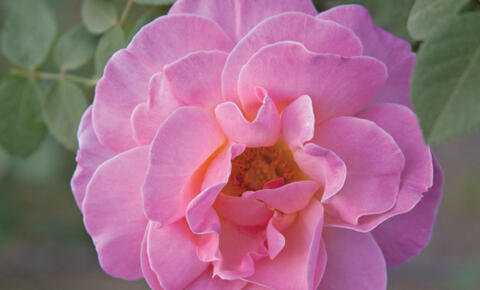
Dr. Eckener
Floribunda roses were developed by a cross between a Polyantha and a hybrid tea in the early 20th century (Poulsen). Floribundas bear flowers in sprays on a usually rounded, well-branched shrub. Bloom form can be diverse, but individual blooms may resemble hybrid teas. Floribundas generally require less work than hybrid teas, making them great garden plants. Their freely blooming nature makes them good choices for mass color in beds. ‘Julia Child’ is an example of a Floribunda.
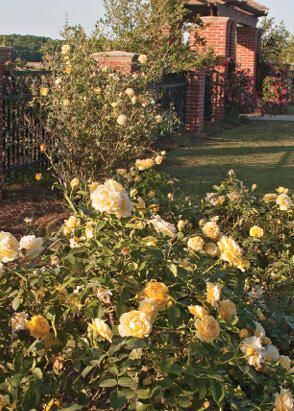
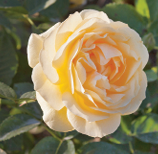
Julia Child
Grandiflora roses resemble hybrid teas in shrub form, bloom form, and hardiness. Blooms occur singly or in small groups at the end of long stems. ‘Queen Elizabeth’ (1954) was the first cultivar to be labeled a Grandiflora. ‘Melody Parfumée’ is an example of a Grandiflora.
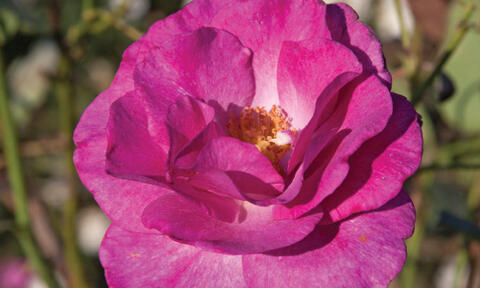
Melody Parfumée
Modern Shrub roses include a genetically diverse and complex group bred from wild species, differing classes, and with some hybrid tea or Floribunda character. Cultivars may be small or large, with upright, spreading, or bushy growth useful in general landscape schemes. Flowers may be small and simple or large and showy and have light to intense fragrance. Most cultivars bloom in repeating cycles or continuously bloom with masses of flowers. Some bear attractive fruit (hips) in the fall. Many of the larger roses can be trained on supports such as pillars, trellises, or walls. ‘Carefree Spirit’ is an example of a shrub rose.
- English roses are a blending of old garden roses and modern roses to create the growth habit, fragrance, and flower formof the old roses with repeat flowering and brighter flowercolors of modern roses.
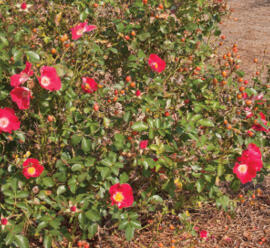
Carefree Spirit
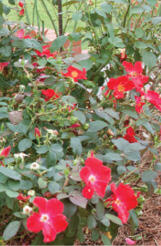
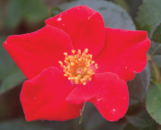
Home Run
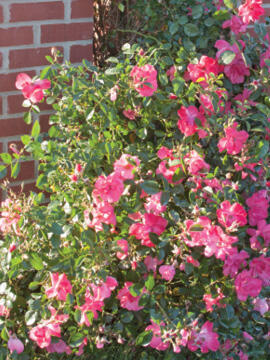
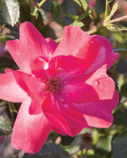
Lady Elsie May
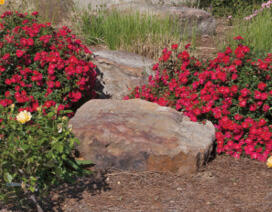
Red Drift
Modern Climbing roses form in the same way as old garden rose climbers. Accepted classes are Climbing Polyantha, Climbing Floribunda, Climbing Hybrid Tea, Climbing Miniature, Climbing Tea, Large-flowered Climber, and Ramblers.
- Climbing Polyantha and Floribunda flowers are generally identical to their original bush forms. Bloom is fairly continuous and hardiness is better than climbing hybrid teas.
- Climbing hybrid tea roses are usually given the same name as the bush variety from which they originated. In general, climbing forms do not bloom as continuously as the parent shrub, but flowers and foliage usually are identical.
- Large-flowered climbers grow slower than ramblers do, are often trained on posts or some other type of support, and may require heavy annual pruning. They are adapted to small gardens for growth near fences, walls, or small trellises. When well grown, flowers are large and useful for cutting. Many varieties do not bloom as freely when canes are trained ver-tically as when trained horizontally.
- Ramblers are very hardy, fast-growing roses. Flowers are small and clustered. Plants flower once an-nually on year-old wood. Foliage is glossy, but many varieties are susceptible to powdery mildew. New cultivars are bred for larger flowers, a long growing season, and powdery mildew resistance. Small groups of rambling roses have been named for the species on which their breeding is based. These subgroups are Ayrshire Hybrids, Sempervirens Hybrids, Multiflora Hybrids, Wichuraiana Hybrids, and Everblooming Climbers.
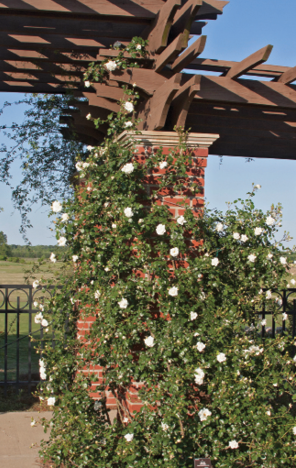
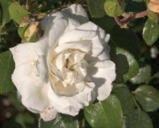
White Dawn
Miniature roses are very small in both growth habit and flower. For most varieties, maximum height is 12 inches. They are used in rock gardens, edging, and potted plants. Miniatures have become very popular since 1970, with many varieties available. ‘Highway 290 Pink Buttons’ is both a miniature and a found rose.
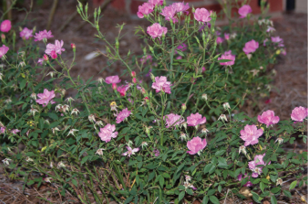
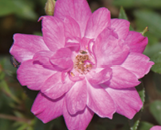
Highway 290 Pink Buttons
Other Groups
Tree or standard roses are those with a trained plant form with unique use. Roses with attractive growth habit and bloom are grafted on rootstock that forms upright trunks. Many popular bush rose varieties are available as tree roses. They are often used in formal plantings, as accent plants, and as potted specimens.
Trailing, procumbent, or groundcover roses are climbing or low-growing, spreading roses adapted to use on slopes, banks, and walls. They produce long canes that creep along the ground, making a pleasing ground cover. Flowers are diverse, simple, or casual in form, but bloom is often continuous and freely produced throughout the growing season. Many of these cultivars are mannerly spreaders, but some are aggressive and can grow out of bounds.
Miniflora or patio roses are becoming popular as roses for small gardens or containers. These roses range in size between floribunda and miniature roses.
Found roses are a group that have been collected from cemeteries, old homesteads, or family sources where the original names have been lost. ‘Peggy Martin’ is an example of a found rose.
The Mystery Roses of Bermuda are a group of warm-climate roses similar to Chinas and teas that have flourished in the gardens of Bermuda for many years. Links to their old garden rose ancestry have been lost, and they have developed in isolation long enough to have acquired local names and lore. They flourish in the tropical island climate where temperate climate roses would not thrive.
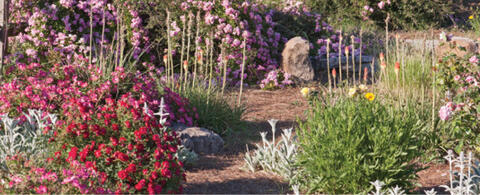
Peggy Martin
Roses for Mississippi Gardens
Mississippi’s climate creates challenges for many rose cultivars, but those with good tolerance to heat, humidity, and diseases will grow well. Most hybrid tea roses perform better if sprayed regularly, but a few survive reasonably well without fungicide treatment if well maintained. The roses listed below have been grown at the Magnolia Botanic Garden (MBG)—Crofton Sloan-Verona; Veterans Memorial Rose Garden (VMRG)—Pamela Collins-Starkville; Truck Crops Branch Station (TCBS)—Bill Evans-Crystal Springs; and South Mississippi Branch Experiment Station (SMBES)—Eugene Blythe-Poplarville.
|
# |
Class |
Cultivar |
Bloom color |
Sprayed/ No spray |
Bloom cycle |
Site |
|
1 |
Species form |
R. banksiae lutea Lady Banks Rose |
light yellow |
no spray |
spring only |
VMRG |
|
2 |
Alba |
Madame Plantier |
white |
no spray |
spring only |
VMRG |
|
3 |
China |
Comtesse du Cayla |
orange blend |
no spray |
repeat |
VMRG |
|
4 |
China |
Cramoisi Supérieur |
medium red |
no spray |
repeat |
VMRG |
|
5 |
China |
Mutabilis |
yellow/pink |
no spray |
continuous |
VMRG |
|
6 |
China/Polyantha |
Climbing Cécile Brünner |
light pink |
no spray |
spring only |
VMRG |
|
7 |
Bourbon |
Kronprinzessin Viktoria |
white |
no spray |
repeat |
VMRG |
|
8 |
Bourbon Climbing |
Zéphirine Drouhin |
medium pink |
sprayed |
repeat |
MB |
|
9 |
Tea |
Duchesse de Brabant |
light pink |
no spray |
repeat |
VMRG |
|
10 |
Hybrid Tea |
Big Ben |
dark red |
sprayed |
repeat |
SMBES |
|
11 |
Hybrid Tea |
Elina |
light yellow |
no spray |
repeat |
VMRG SMBES |
|
12 |
Hybrid Tea |
Frederick Mistral |
light pink |
sprayed |
repeat |
MBG |
|
13 |
Hybrid Tea |
Granada |
yellow/red blend |
sprayed |
repeat |
SMBES |
|
14 |
Hybrid Tea |
Jane Pauley |
orange blend |
no spray |
repeat |
VMRG |
|
15 |
Hybrid Tea |
Lemon Spice |
yellow |
sprayed |
repeat |
SMBES |
|
16 |
Hybrid Tea |
Marijke Koopman |
medium pink |
sprayed |
repeat |
SMBES |
|
17 |
Hybrid Tea |
Mr. Lincoln |
dark red |
sprayed |
repeat |
MBG |
|
18 |
Hybrid Tea |
St. Patrick |
yellow blend |
sprayed |
repeat |
MBG |
|
19 |
Hybrid Tea |
Tahitian Sunset |
apricot blend |
no spray |
repeat |
VMRG |
|
20 |
Hybrid Tea |
The McCartney Rose |
medium pink |
sprayed |
repeat |
MBG |
|
21 |
Hybrid Tea |
Paradise |
mauve |
sprayed |
repeat |
SMBES |
|
22 |
Hybrid Tea |
Pat’s Choice |
orange red |
sprayed |
repeat |
SMBES |
|
23 |
Hybrid Tea |
Rio Samba |
yellow blend |
sprayed |
repeat |
SMBES |
|
24 |
Hybrid Tea |
Tanchored blend |
sprayed |
repeat |
SMBES |
|
|
25 |
Polyantha |
Perle d’Or |
yellow blend |
no spray |
repeat |
VMRG |
|
26 |
Polyantha |
The Fairy |
light pink |
sprayed |
repeat |
MBG |
|
27 |
Hybrid Musk |
Ballerina |
medium pink |
sprayed |
repeat |
MBG |
|
28 |
Hybrid Musk |
Buff Beauty |
apricot blend |
no spray |
repeat |
VMRG |
|
29 |
Floribunda |
Europeana |
dark red |
sprayed |
repeat |
MBG |
|
30 |
Floribunda |
First Kiss |
pink blend |
sprayed |
repeat |
SMBES |
|
31 |
Floribunda |
Miss Ada |
light pink |
sprayed |
repeat |
SMBES |
|
32 |
Floribunda |
Our Lady of Guadalupe |
pink blend |
sprayed |
repeat |
SMBES |
|
33 |
Grandiflora |
Candelabra |
orange |
sprayed |
repeat |
SMBES |
|
34 |
Grandiflora |
Melody Parfumée |
mauve |
no spray |
repeat |
VMRG |
|
35 |
Grandiflora |
Queen Elizabeth |
medium pink |
sprayed |
repeat |
MBG |
|
36 |
Shrub |
Carefree Marvel |
deep pink |
no spray |
continuous |
VMRG |
|
37 |
Shrub |
Carefree Spirit |
red blend |
no spray |
continuous |
VMRG |
|
38 |
Shrub |
Home Run |
medium red |
no spray |
continuous |
VMRG |
|
39 |
Shrub |
Pink Home Run |
deep pink |
no spray |
continuous |
VMRG |
|
40 |
Shrub |
Knockout |
red blend |
sprayed/no spray |
continuous |
MBG VMRG TCBS |
|
41 |
Shrub |
Double Knockout |
medium red |
sprayed |
continuous |
MBG |
|
42 |
Shrub |
Blushing Knockout |
light pink |
sprayed |
continuous |
MBG |
|
43 |
Shrub |
Double Pink Knockout |
medium pink |
sprayed/no spray |
continuous |
MBG VMRG |
|
44 |
Shrub |
Lady Elsie May |
orange/pink |
no spray |
repeat |
VMRG |
|
45 |
Shrub |
Coral Drift |
orange/pink blend |
sprayed |
continuous |
MBG |
|
46 |
Shrub |
Peach Drift |
apricot blend |
sprayed |
continuous |
MBG |
|
47 |
Shrub |
Pink Drift |
deep pink |
no spray |
continuous |
VMRG |
|
48 |
Shrub |
Red Drift |
medium red |
no spray |
continuous |
VMRG |
|
49 |
Shrub |
Sweet Drift |
light pink |
sprayed |
continuous |
MBG |
|
50 |
Large-flowering Climber |
White Dawn |
white |
no spray |
repeat |
VMRG |
|
51 |
Hybrid Multiflora (Found) |
Peggy Martin |
medium pink |
no spray |
continuous |
VMRG |
|
52 |
Miniature (Found) |
Highway 290 Pink Buttons |
medium pink |
no spray |
continuous |
VMRG |
|
53 |
Miniature Red Cascade |
red |
no spray |
continuous |
SMBES |
Roses in the Landscape
A few words about design
Roses have been grown in gardens and landscapes for all kinds of reasons throughout history. They have been found in herb gardens, medicinal gardens, monasteries, estate gardens, public gardens, dooryards, courtyards, cutting gardens, in both formal and landscape designs…wherever their color, form, and fragrance is needed. They fit well in all design styles, from traditional to contemporary. Roses are like an all-around utility player. They can play nearly any role in the garden, with the possible exception of foundation plantings.
Hybrid tea roses have been the most recognized rose type for much of the past century. The form of the shrub and the flowers has made this the ideal rose for formal garden design. On the other hand, Floribunda, Polyantha, and shrub roses, with their continuous cycles of heavy flowering, are well suited for mass color display. These come in numerous colors, forms, and sizes, from large shrubs to minifloras and groundcovers. Many of the newest cultivars are great for beds at the base of hedges and shrubbery borders, and they are now used in commercial plantings at shopping centers and gas stations. The best selections are sufficiently disease-resistant to be grown without regular spraying.
Old garden roses are making a real comeback in popularity. Many gardeners are enchanted with the old rose forms, the fragrance, and the elegant growth habits of the best selections. These play well next to traditional architecture and warm brick facades. Besides, in the right place, the old roses can thrive with little effort and little or no spraying. Many of the climbing cultivars are suitable for vertical or horizontal training on supports such as posts, trellises, fences, or walls. The old garden roses have a softness that the modern roses have lost. On the other hand, the clear colors and bold forms of modern shrubs and climbers may provide bright accents that stand up to contemporary architecture.
Location, location, location
Some cultural tips are in order when planning where to place roses. A few old roses will tolerate a little shade, but all roses really prefer full sun to grow and flower their best. Roses require at least 6 hours of sun daily but prefer 8 to 10 hours. Morning sun is best if there will be some daily shade from trees or buildings. Light shade during early afternoon is certainly not required, but if you have such a location, it can provide a little relief from summer heat.
Healthy plants need plenty of air circulation, but they should be sheltered from blasts of cold winter wind, especially if they are tender. A nearby hedge or fence is useful, but it should not be close enough to shade the shrubs or reduce root space. Roses have historically been grown in protected sites, such as walled gardens and courtyards. But they need adequate space to develop without being crowded by structures or other plants. Low-lying parts of the garden, where frost collects during the winter, are not good locations for roses. Such sites can also be wet if not well-drained, and most roses prefer good- quality, well-drained soils.
Roses grown primarily for cutting should be generously spaced out in an open location with plenty of sun and air circulation to keep disease pressure down. Easy access is especially important if the roses will need regular spraying and pruning. Design the garden or beds so that water is easily available. Dedicated water lines or faucets allow for the flexibility of drip lines on timers to reduce the work of watering. Careful selection of highly disease-resistant, low-maintenance roses is critical if they will be located out in the larger landscape where regular grooming is impractical. Consider the time and effort to keep your roses looking great. A few great-looking roses in a manageable landscape will be much more rewarding than a field of roses that wear out the gardener trying to keep them alive.
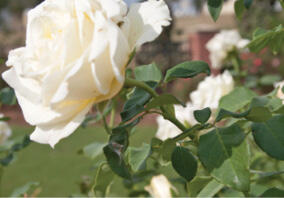
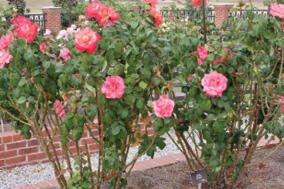
A few words about spacing rose plants
Space roses according to how large they will grow at maturity. Some roses can become very large, especially landscape roses, such as shrub roses, some of the old garden roses, and climbers. Some roses do not tolerate heavy pruning and should be spaced accordingly. Large roses may need to be spaced 6 to 15 feet apart. Give roses adequate room to reduce pest and disease spread, and to provide access for pruning or spraying activities, especially if you plan to highly groom your roses for close-up display, cutting, or exhibition competition. Specific recommendations are highly variable.
Spacing Roses
- Large shrubs – 6–15 feet
- Hybrid tea garden – 5–6 feet
- Massed roses – 3–4 feet or more, depending on mature size
- Miniature roses – 12–18 inches
So, are you ready to plant some roses? Let’s start at the beginning.
Buy good roses.
Buy your roses from reputable dealers. Local nurseries and garden centers are good sources. Mail-order companies will send you colorful catalogs listing the plants they sell. Or go online and spend some time looking at the leading plant websites. The diversity of companies and products can be overwhelming. Be sure that you look around long enough to know that you are getting what you want and that the site is secure. You can find everything from the latest introductions to the rarest of old garden rose cultivars. Place orders early to get the best and freshest plants.
Roses can be purchased as bare-root or container-grown plants. Each has its advantages and disadvantages. Bare-root roses may be a little less expensive because the grower is not shipping the weight of potting soil and pots. But bare-root roses must be planted or potted as soon as they arrive. Container-grown roses are easier to time, as the roots are protected by potting media. They can arrive still dormant, or they may already be leafed out. Roses in leaf need to be protected until after the last frost date. Container-grown roses are usually placed out for sale later in spring than bare-root roses.
Bare-root roses appear at nurseries, garden centers, and big-box stores in late winter to early spring about the same time as other bare-root nursery stock. Planting bare-root roses directly into the garden can be very successful if the roses are fresh and the planting site is ready. The roots should look plump and fresh, and the top of the plant should still be dormant. Avoid dried-out plants that have been in unprotected locations for days with extreme temperature changes. Fresh is best: do not delay planting.
Container-grown roses may be planted successfully anytime of the year. Avoid the heat of late summer if possible. Fall is a good time to plant if plants are available at the nursery and ready to be planted. Roses completely grown in pots can be ready anytime, but often roses are dug bare-root, shipped to nurseries or garden centers, potted, and grown before being placed out for sale in spring. Check carefully before purchasing, as some of these roses may not be ready to plant when sold.
Take time to plant roses correctly.
Sometimes roses die or fail to thrive because they are not planted well. Remember the old adage to put a 50-cent plant in a dollar hole. That does not mean to plant a cheap plant. It means to prepare a great planting hole for the plant that is to go into it. There is more to planting roses than just digging a hole and putting it in.
Roses can be planted one rose at a time in a landscape setting, or they can be planted in beds. The process is similar, but the planting site can have very different soil characteristics depending on how the site is prepared.
Can I grow roses in my soil?
Soil conditions can determine if a rose will struggle or thrive. Some rose cultivars can handle poor soils, so do some research if you have poor soils that cannot be corrected. Peter Beales’s Classic Roses and Roses are two good resources to use. In these cases, cultivar choices become critical for success. Soils with lots of clay, poor texture, and internal drainage can be very difficult to improve. The same can be said for soils with high lime content or soils that are poorly drained, waterlogged, or acidic. Under extreme soil conditions, consider adapted species other than roses.
Most roses prefer a medium-textured to sandy loam soil with good internal drainage that is rich in organic matter
and nutrients. Roses will grow well in a slightly acidic range of pH 5.8 to 7. Acid or alkaline conditions outside this range will benefit from adding sulfur or lime if the soil type is capable of adjustment. Roses that are placed out in the landscape should be planted the same way as any landscape plant. Use the soil that comes out of the hole rather than backfilling with amended soil. This encourages the roots to grow outside the hole rather than circle around within the porous, organic backfill or drown from water that cannot drain away inside the planting hole.
For more information on soil pH, see MSU Extension Publication 2831 Adjusting Soil pH in Mississippi Landscapes.
Quick Tips on Bed Preparation
- Get a soil test.
- Prepare bed in fall.
- Till or spade 6–12 inches deep.
- Till or spade in 2–3 inches of organic matter.
- Adjust pH if soil test recommends.
- Cover with 2–3 inches of mulch.
- Plant in early spring.
Prepare your bed for roses.
Planting beds intended for multiple roses or mixed ornamentals benefit from bed preparation prior to mass planting, especially if the soil has problems. Bed preparation allows you to loosen the soil and add organic amendments to improve texture and drainage. This technique works equally well whether the bed is part of the overall landscape design or segregated into a boxed bed, such as in a cutting garden plot. Beds raised above the existing soil may be the only solution if the soil is too difficult to correct.
Conduct a soil test before starting to dig. Find kits and instructions for soil tests online or from your county MSU Extension office. The report will tell you the soil pH and list nutrients the soil needs over the next year. It will also tell how to correct soil pH or soil deficiencies at the time you prepare the bed. To start, till or spade the soil 6 to 12 inches deep.
Spread 2 to 3 inches of organic amendment over the surface, and till or spade it into the loosened soil. Organic material can be well-composted leaves or sawdust, peat moss, or composted fine pine bark amendment. Early to mid-fall is an excellent time to prepare fresh beds, after a few rains make the soil easy to dig but before winter turns the soil to mud. Cooler weather is easier on the gardener, and the fall timing allows amendments such as lime or sulfur several months to take effect before spring planting. Cover the finished bed with 2 to 3 inches of mulch and allow the ingredients to rest until the roses become available for purchase in the spring. The finished bed will be somewhat raised above the surrounding area, which helps with drainage. With good care, this effect will remain for years.
Now, let’s plant!
The process of planting a bare-root rose is the same whether the rose is in an individual hole or within a prepared bed. Dig the hole to be at least twice the width of the root mass and approximately 12 inches deep. Make a small mound of soil in the planting hole as shown in the drawing. Spread the roots over the mound and set the plant to the same depth as it was grown. Crumble and place soil gently back into the planting hole around the roots, and firm with hand pressure only.
Place 2 to 3 inches of mulch around the newly planted rose. Do not pile mulch against the stems or canes. Water the soil thoroughly immediately after planting. The roots and the soil around them should be evenly moist and settled. Avoid planting too high or too deep.
Planting containerized roses is very similar to planting bare-root roses. The hole should be as wide as described above, but the finished depth of the hole should be no deeper than the height of the container so that the soil ball sits on firm soil and will not sink into the hole after watering. Loosen the soil ball from the sides of the pot by rolling the container on its sides and gently compressing the soil ball. Ease the plant out without damaging the main stem or canes or stretching the stems and roots apart. If the plant is root-bound, you may need to cut the pot to remove the soil ball. Inspect the soil ball for root health before planting. Ideally, the soil ball should have a network of healthy roots showing on the surface and holding the soil mass together. Blackened, dead roots or rotting, saturated potting media are not indicators of good plant viability. Roses with masses of circling roots may have trouble getting established. You may be able to correct the problem by unwrapping or cutting away at least the surface roots before planting. This may seem drastic, but do not be afraid to do it. Roots will grow back if they are healthy. Loosen or rough up the outer surface of the soil ball to be sure that the roots come in good contact with the soil. Place in the hole so that the top of the soil ball is slightly higher than the surrounding soil level, then backfill until the soil ball is completely covered, firming the soil with hand pressure only. Mulch exposed soil and water thoroughly as described above so that the backfilled soil and soil ball are evenly moist and settled.
Mulches can be a real help.
Roses establish better when the soil surface is covered with mulch. Mulches keep the soil surface from drying out, insulate the ground from temperature fluctuations, and reduce weeds. Mulches may be organic or inorganic. Pine straw, shredded hardwood, or pine bark mulches are commonly available and work well with roses. Maintain a depth of 2 to 3 inches, and do not pile mulch up around the base of the plant.
Water your roses regularly just after planting.
Roses need evenly moist soil, especially when first planted. Roses generally need 1 inch of water a week if it does not rain. They should be able to handle a little less water after the plant becomes well established, but watch for stress under drought conditions. Water deeply so the root zone gets completely moist. A drip system can be a real time- and water-saver if you put it on a timer. A drip system also keeps the foliage dry, which helps reduce disease levels. Water rose shrubs in the morning so the foliage can dry before evening if you water by hand or by overhead sprayers.
Fertilizing quick tips
- Get a soil test.
- Keep a garden journal.
- Watch for deficiency signs.
- Fertilize during growth, approximately 6–8 weeks apart.
- 1 pound nitrogen per 1,000 square feet per application.
- Start mid-March.
- End mid-August/early September.
- Water fertilizers in.
- Adapt applications according to type of fertilizer.
- Read labels before use.
There are so many fertilizers. What do I do?
Decisions about fertilizing are easier if you continue to take a soil test every year or two, preferably in the fall. Then you can make a fertility plan based on real data that you track over the years. The reports tell you what fertilizers or amendments are needed and when to apply. Their recommendations list commonly available fertilizers that you can use as a baseline. There are many different fertilizers on the market, some formulated just for roses. There are also specialty products that correct specific deficits, such as iron or micronutrients. Costs can be very different from one product to another. Read the labels carefully. For more information, see Extension's Soil Testing page.
Consider if you want a fast-action fertilizer or a slow-release fertilizer. You can get complete fertilizers that contain nitrogen, phosphorus, and potassium, or you can get single-nutrient formulas if your soil needs only one nutrient.
There is also the option of using organic fertilizers. These come in many forms, but they often are used for reasons other than fertility. Nutrient levels in organic fertilizers are not as predictable as those in standard fertilizers. They may be available locally in bulk forms, such as composted manures or municipal composts, for a small cost or free. Some organic fertilizers have desirable soil-building properties.
Fertilizer sources and amounts depend ultimately on the condition of the soil and your objectives in growing roses. You have met your basic goals if the plants are healthy. Overfertilizing can lead to pests, diseases, poor bloom, and environmental problems.
Fertilization recommendations vary by the type of fertilizer used, the method of application, the condition and type of roses, and the objectives of the gardener. Fast-release or liquid fertilizers may need to be applied in small amounts on a more frequent schedule. Slow-release fertilizers may be applied only a couple of times per year. Established landscape roses may need little to no fertilizer if the soil is in good condition. Roses in containers where leaching is high and roses grown under strict regimes for maximum bloom production may need much more fertilizer per year than average conditions.
Sometimes roses are said to be heavy feeders, but that may be due to how they are being grown if high-quality, maximum bloom is the objective. General recommendations for shrubs are to fertilize every 6 to 8 weeks with 1 pound of nitrogen per 1,000 square feet per application.
Composts and organic fertilizers release nutrients slowly, so they can be applied just before leafing-out. In general, fertilize after plants initiate growth. Fertilizing in early spring while the plant is still dormant wastes nutrients that simply leach through unresponsive roots. To avoid frost-prone late-season growth, do not fertilize plants after early September. Apply fertilizers to moist soil of unstressed roses; water if necessary before applying. Fertilizers should be watered into the soil immediately after they are applied.
Pruning Quick Tips
- Identify the type of pruning best for the rose class. Get a game plan in mind.
- Do heavy pruning mid-February to mid-March for repeat bloomers. Prune after bloom for spring bloomers.
- Use sharp, clean tools and disinfect between cuts and plants.
- Wear protective clothing/gloves.
- Prune out dead/diseased wood.
- Prune to open plant up for air circulation, fit space, and reduce disease.
- Deadhead, shape, and clean most roses to promote flowering and reduce disease.
For more information on fertility issues, see the Extension Fertility page.
To prune or not to prune? That is the question.
Most garden roses need some pruning to perform their best in gardens and landscapes. The need to prune varies greatly from class to class. Some old garden roses, like China roses, respond poorly to heavy pruning, while hybrid tea bushes need moderate to severe annual spring pruning.
Most roses come ready to plant and do not need to be pruned much. Examine the canes carefully for breakage or any signs of disease, which should be trimmed out at the time of planting. Canes should be cut at an angle approximately one-fourth inch above an outward-facing node. To prevent a delay in flowering, do not cut canes shorter than 10 inches.
The major annual pruning for most repeat-blooming cultivars should occur each year between mid-February and mid-March, when the roses are still dormant but winter’s worst weather is past. Pruning roses is not difficult, but it does require clean, sharp tools and protective gloves and clothing. Wipe your tools with a disinfectant, such as a 10 percent bleach solution, bleach wipes, or alcohol, between diseased cuts and especially between plants. Spring pruning allows you to evaluate the condition, shape, and size of a rose bush and prepare it to serve the purpose for which it was planted. The degree of pruning depends on your goals for that plant and its physical condition. The objective at the end of pruning is to have a shrub free of dead, diseased, and weak growth, leaving healthy canes and an open, pleasing form prepared to support vigorous new growth.
For more information on disinfectants, see Extension Publication IS1955 Choosing a Disinfectant for Tools and Surfaces in Horticultural Operations.
Hybrid teas, Grandifloras, and many larger Floribundas respond positively to heavy annual pruning and are pruned similarly. First, remove all dead or diseased-looking wood. Then, cut out all the weak canes and any branches that are growing toward the center of the bush. For hybrid teas and Grandifloras, select three to six strong canes and cut them back to a height of 12 to 18 inches. Roses grafted to R. x fortuniana rootstock are normally larger shrubs and should be pruned less, leaving more canes and keeping the final height to about 30 inches. Leave more than six canes on bushy Floribundas, and leave them at a height of 24 to 30 inches, depending on their mature size, location, and purpose in the landscape. For a video demonstration on pruning hybrid tea roses, see How to Prune Hybrid-T Roses.
Modern shrub roses and English roses should be cleaned as described above. Reduce their overall size by approximately one-third. Retain the natural shape of the shrub unless the plant is being trained to a trellis or fence. In general, old garden roses should not be pruned much. Clean out dead or diseased wood, but maintain their natural form.
Trim roses that bloom only in spring after the flowering has ended because they produce their flowers on wood of last season’s growth. In general, pruning spring-bloomers and climbing roses usually involves cleaning the plants of dead or diseased growth and shaping the plants to their natural or desired growth pattern. Some climbing roses can be rejuvenated every year by cutting out one or two of the oldest canes that no longer bloom well. Roses that are trained to grow vertically may tend to bloom only at the top of the main stems. Reducing the top of the main stem slightly and encouraging growth of horizontal side stems will promote better bloom throughout the column of the plant.
How should I cut blooms?
Many gardeners grow roses to cut flowers for home and friends. The long, single-stem blooms of hybrid tea roses are perfect for cut flowers. Use hand pruners that cut like scissors to make the cut at a five-leaflet leaf (see illustration). Cuts in this area ensure strong vegetative breaks and encourage a bushy plant. Rose exhibitors often want to produce the biggest, boldest, best bloom they can for flower shows. They achieve this by disbudding a stem. Disbudding is the process of removing all side buds except the terminal bud at the tip of the stem when the buds are small. All the growing energy is, therefore, concentrated into the terminal flower.
What is deadheading and why is it important?
Most roses respond well to the removal of blooms that are past their prime. Some of this occurs as you cut flowers for arrangements. Flowers that do not get cut for those purposes should also be trimmed off the shrub to encourage new vegetative growth that will bloom again. Cut off less foliage if the plant is young or under stress. Cut farther down the stem if the plant is actively growing and the canes become top-heavy. Lightly reshaping the shrub about midway through the growing season is often referred to as summer pruning.
Stop pruning in early fall so that the shrub does not go into winter with tender new growth. Deadheading and summer pruning are good times to groom the shrub and remove unsightly dead blooms, diseased foliage, and fallen leaves.
Roses that bloom in sprays also benefit from deadheading. Wait until the entire spray is mostly finished, and then remove the whole group of spent flowers at one time.
Not all roses need this much attention. There are many cultivars whose blooms are simple and self-cleaning. These cultivars make good landscape shrubs, although they may not be the best choice for exhibition flowers. They make up for the lack of fancy flowers by producing masses of flower color all season long.
Can I propagate my roses?
It is best to buy named, healthy, vigorous, 2-year-old plants from a reliable nursery where propagation and production conditions are well controlled. Propagation of patented plants is not legal unless the breeder gives permission. Many of these roses are grafted onto rootstocks because they are not strong enough to grow on their own roots, or they require a long establishment time if grown without grafting. A common rootstock used on grafted roses throughout the United States is ‘Dr. Huey’. ‘Dr. Huey’ is a red-blooming rose with long, arching canes. This growth habit and bloom color appear when the scion (the top part of a grafted rose) dies or is overgrown by the rootstock. R. x fortuniana rootstock can be found on grafted roses where rose exhibitors and gardeners seek more robust growth. This rootstock is not quite as cold-hardy as ‘Dr. Huey’ but is an exceptional rootstock in the Deep South. It grows naturally as a large climber with small, white blooms.
Old garden roses and non-patented roses are legal to propagate, and many can be grown on their own roots. That is how some old family roses get passed down through generations, losing their identity but still making good memories. Roses can be shared in this manner by rooting hardwood or softwood cuttings or potting up root suckers. Some roses are easier to root than others.
Insect and Disease Pests of Roses
There are many diseases, insects, and mites that attack and damage roses. Some of these are minor pests, while others can cause serious damage if not detected and treated early. Although rose growers can use many non-pesticide methods to reduce the potential for pest outbreaks, sometimes pesticide applications are required to protect roses from diseases, insects, or mites. Check your rose plants regularly so you can detect and treat problems before they cause serious damage.
When multiple pests require treatment, it is often practical to combine recommended insecticides, miticides, or fungicides into one spray, but read the labels of all involved products carefully before tank mixing. When spraying your roses, keep in mind that pesticides do not work unless they reach the target pest, so take care to spray thoroughly. Directing sprays to the undersides of leaves is especially important when attempting to control spider mites, diseases, and certain other pests.
Caution: Mix only the amount you will need for one application. Do not store pesticides after they are mixed with water. For safe and effective pesticide use, always read and follow label directions.
Insects
Some of the more common or important rose pests are briefly discussed in the following paragraphs. See Extension Publication 2472 Insect Pests of Roses for more specific information on the insect and mite pests of roses and how to manage and control these pests.
Thrips: Thrips are tiny, spindle-shaped insects that damage blooms by feeding on the petals of developing buds, causing petals to be distorted and discolored. Light-colored blooms are generally more susceptible, but thrips will injure dark-colored blooms, as well, especially when numbers are high. Infestations are heaviest in spring and early summer, when adult thrips are migrating from maturing spring weeds, clovers, and winter grain crops.
Chilli thrips: Rose growers need to be alert for this nonnative species of thrips that threatens to become established in the state. Unlike other thrips, chilli thrips feed primarily on foliage, causing leaves to be distorted and discolored, but they will also damage blooms. Damage by chilli thrips is sometimes mistaken for herbicide injury. Use a hand lens to check the undersides of symptomatic leaves for the presence of thrips. Heavy infestations can cause severe damage and can even result in complete defoliation.
Aphids: These small, soft-bodied insects cause damage by sucking the sap from leaves, flower buds, and tender stems. Heavy infestations cause distorted and stunted growth. Aphids also produce large amounts of honeydew, which causes plants to be sticky. It also supports the growth of sooty mold fungi, which produces an unsightly black growth on the leaves of affected plants.
Rose scales: Rose scales and other armored scales are immobile, somewhat oyster-shaped insects that damage roses by feeding on the canes with their long, thread-like mouthparts. Rose scales do not produce honeydew, and infestations are easy to overlook because they adhere closely to the stem and are often mistaken for bark or debris. Heavy infestations cause plants to be unthrifty and can even cause death of whole canes.
Spider mites: These tiny arthropods are some of the most common and most damaging pests of roses. They feed on the undersides of leaves, sucking sap from individual plant cells. Damage initially appears as a light-colored stippling of the leaves, usually beginning along the mid-vein. Use a hand lens to check the undersides of such leaves for mites. Heavier infestations cause leaves to have a bleached or bronze-colored appearance and to turn brown eventually and drop from the plant. Spider mites are often kept in check by natural predators, so one important way to manage spider mites is to avoid unnecessary insecticide treatments. Many of the insecticides recommended for control of other rose pests have a tendency to trigger spider mite outbreaks. Although it is sometimes necessary to use these products, you do not want to do so unless you really have to. Hot, dry, dusty conditions also favor mite outbreaks. Choose spider mite treatments carefully; spraying spider mite infestations with ineffective products will cause the infestation to become worse!
Leaf-cutter bees: Leaf-cutter bees are solitary bees that sometimes cause minor, but rather obvious, damage to rose leaves by cutting circular discs of leaf material to use in their nests. Nests are built in hollow, tube-shaped holes that are approximately the diameter of a pencil. Occasionally an especially industrious bee, or group of bees, will create enough leaf damage on an individual plant or group of plants to cause concern, but this defoliation is usually not severe enough to cause long-term adverse effects.
Japanese beetles: Fortunately, these nonnative insects do not occur statewide, but Japanese beetles are serious pests of roses wherever they occur. Damage is caused by the adults, which feed directly on the blooms, causing unsightly damage. Light-colored blooms are more favored, but all colors are subject to damage. They will also feed on leaves. Currently, the heaviest Japanese beetle populations occur in the northern part of the state, but infestations are spreading. Japanese beetles are relatively easy to identify by their bronze and green color and the small tufts of white hair that appear along the edges of their wing covers.
Rose midges: Although rose midges are not common in the state, rose growers need to be aware of this insect and the damage it causes. Actually, you are not likely to see the insects themselves because they are tiny, mosquito-like flies. Heavy rose midge injury is hard to overlook, but it is often not recognized as insect injury. Rose midge larvae feed in developing shoot tips and flower buds, causing them to be blackened and distorted, resulting in death of the shoot tip and reduced bloom production. Heavily infested plants will produce few blooms. This insect produces many generations per growing season.
Fire ants: Fire ants rarely damage roses directly, but their mounds are unsightly in the rose garden and surrounding landscape, and their stings are painful and annoying. It is difficult to fully enjoy a rose garden or landscape that is heavily infested with fire ants. Fortunately, there are effective treatments that can be used to control fire ants; long-term success requires ongoing effort. See Extension Publication 2429 Control Fire Ants in Your Yard for information on how to best control these vexing and persistent pests.
Diseases
Rose cultivars differ in their susceptibility to various diseases, but, because of our diverse climate and soils, most roses will eventually have a problem with one disease or another. Knowing something about common rose diseases and when a preventive disease control program might be necessary can help you be a successful rose grower.
A preventive disease program requires that you know what a healthy plant looks like and that you check your roses’ health once every 2 weeks. If the weather favors a disease, start a preventive management program. If you suspect a disease and can identify it, you should apply recommended products. If you do not know what the problem is or cannot identify it, send a sample of the problem and receive a diagnosis and recommendation. Send the sample to:
Extension Plant Pathology Lab
190 Bost North, Rm. 9
Mississippi State, MS 39762-9612
(662) 325-2146
(662) 325-8336 (fax)
Please contact your county MSU Extension office or visit the Plant Diseases and Nematode Diagnostic Services page for a current list of sample fees.
The most common diseases that infect roses are caused by fungi or viruses. One is caused by a bacterium. Black spot, powdery mildew, and stem cankers, the three most prevalent and most costly diseases of roses in Mississippi, are caused by fungi.
Always pay attention to weather conditions and take preventive action before a disease gets out of control. Management and fungicides work best when used preventively.
Black spot (Diplocarpon rosae): Black spot is the most common disease of roses in the United States. It affects the aboveground portion of the plant and defoliates leaves and causes cane blotches. While black spot can be found on all roses, it is most severe on some types of hybrid tea roses, especially those bred for their showy flowers. A regular preventive program should be employed for these roses.
The most prominent symptom of this disease is a black spot, which may occur on either side of the leaf. A number of other diseases cause dark spots on the leaves, but you can distinguish black spot by the darker color and the border of the spots, which appear to be fringed, hairy, or feathery. Black spot also infects the stems or canes. Cane lesions may not have the fringed border.
The first symptom will be a small, pin-head sized lesion. Depending upon the genetics of both the rose and the fungus, the plant may hold its leaves until the black spot grows to the size of a dime, or the leaves may fall soon after infection, before you notice the black spots. Premature defoliation is a symptom of the disease.
Depending on the susceptibility of the plant to black spot, you may see a little to a lot of chlorosis, or yellowing, around the black spot lesion. In general, the more chlorosis, the more quickly the leaf is likely to fall from the plant.
When unchecked, black spot can completely defoliate the rose plant. Repeated defoliations weaken the plant and make it more prone to dying from other causes. The fallen leaves harbor the fungus, and it moves from them to infect the new leaves the following spring.
Control. The first step toward controlling black spot is sanitation. If only a few leaves show symptoms of black spot on a plant, remove and destroy them. Remove all diseased leaves from around the plants, particularly at the end of the growing season. The fungus overwinters in diseased leaves and in the canes. It is sometimes wise to prune canes drastically, without cutting too close to the graft, before new growth begins in the spring. Before new foliage occurs, remove and burn all old mulch. Replace with new mulch.
An effective spray program depends upon understanding the life cycle of the fungus that causes black spot, Diplocarpon rosae. The fungus depends upon little “seed-like” structures, called spores, to move to new infection sites. Most commonly, the spores move from infested leaf residue at the base of the plant or from fruiting stem lesions. They may also be borne by the wind to the rose.
Once on the plant, the spores require water and high humidity to germinate. The longer free water (dew, rain, and irrigation water) is present, the lower the humidity can be. The higher the humidity is, the shorter time free water needs to be present. The fungus can germinate and infect the plant from 32ºF to almost 92ºF, but at the lower and higher temperatures, the infections will not express until more favorable temperatures are reached. The most favorable temperatures for disease development range from 64ºF to 75ºF.
Because of this life cycle, fungicide applications should start as soon as any leaves appear on the canes, including during January and February “warm periods.” A study has shown that black spot-susceptible rose plants that were sprayed appropriately during the winter had better health in the spring and summer. Fungicides used for these sprays should not include the class of fungicides called the triazoles (propiconazole, tebuconazole, metconazole, and myclobutanil) as they can interfere with leaf emergence the following spring.
A spray program should require no more than 15 minutes every 2 weeks if you have 10 or fewer rose plants, but it should be done regularly. The protective sprays should continue throughout the spring, summer, and fall. Triazole-type fungicides can be used once the plants are leafed out, in the spring through fall. These fungicides are active enough that sprays every 2 weeks should suffice.
For specific spray recommendations, please see Extension Publication 2827 The Plant Doctor: Black Spot, Cercospora Leaf Spot, and Powdery Mildew of Roses and Publication 2705 The Plant Doctor: How to Spray Fungicides to Protect Landscapes, Gardens, and Turf on Residential Property.
Cercospora leaf spot (Cercospora sp.): This leaf spot can also defoliate roses, including some types that are not especially susceptible to black spot. Symptoms start as a light pink to purplish spot. As the spot enlarges, the center turns gray, but the margin of the spot remains purplish. The lesion is circular.
Management. Use the same management procedures as recommended for black spot.
Stem cankers and die-back: These are among some of the most serious diseases of roses in the South. Caused by a number of fungi, these diseases work similarly in that they infect the rose canes and block the flow of water and nutrients to the upper part of the cane, which dies.
Stem cankers start as a brownish to black stem lesion that may lengthen fairly rapidly. The lesion may stay on a single side of the stem, or it may girdle it. Girdling will cause the cane above the lesion to completely die back.
The first line of protection against these diseases is to select only disease-free plants for your garden. Practicing good sanitation, such as removing fallen leaves and decaying blooms each dormant season, is also helpful.
Thirdly, it is important to prune the canker out as soon as you see it. Cut well below the canker (about 5 inches), and carefully inspect the cut wood to ensure there is no discoloration inside of the cane. Discoloration of the interior of the cane would indicate the disease has moved lower in the stem than you have cut. Clean and disinfect your pruners and recut lower down. Remove and destroy the cane.
If your roses are grafted, do not allow the cankers to enter the graft. You will probably lose the rose if a canker disease enters the graft area. Roses on their own root stock may or may not survive pruning near the crown area of the plant.
After pruning cankers, remove and destroy the diseased tissue. Use a fungicidal spray containing a topical active ingredient, such as mancozeb or chlorothalonil.
Canker diseases are more prevalent on plants weakened by other problems, such as those defoliated by black spot. Stem canker outbreaks also seem to be worse in springs following winters that had frequent and large temperature swings. Thus, it is important to maintain the health of your rose plants so they can better fight off an infecting canker. The fungicide chosen may depend upon the type of canker.
Powdery mildew (Sphaerotheca pannosa): A white, powdery fungus growth on the surface of leaves, buds, or stems of roses usually indicates powdery mildew. Infection on young leaves may cause curling and leaf distortion. A reddish to purplish coloration may be present. Badly infected flower buds do not open. In some situations, young canes may be killed.
The disease is more common on older rose types, especially some climbers and bushes. The disease is more likely to infect these plants when they are grown in shady areas.
Management. Most of the sanitation and management procedures for black spot are also valuable in controlling powdery mildew. During the growing season, you can hold mildew in check by spraying with various fungicides. If the plant is only somewhat susceptible to powdery mildew, the Cornell rose formula may be effective. Please see Publication 2827 The Plant Doctor: Black Spot, Cercospora Leaf Spot, and Powdery Mildew of Roses. During late winter, a spray of dormant plants with a commercial lime-sulfur 1:15 solution can be effective.
Gray mold (Botrytis cinerea): Gray mold is a common infection of old buds and blossoms. In the right conditions, it will also infect canes.
Gray mold infection starts as a grayish-black lesion on the infected terminal and will extend down the stem of the infected cane. Infected buds may appear blasted and will droop over at or near the lesion. During warm, humid weather, a gray fungus may cover the infected parts. When you examine the affected area, you may find a powdery gray to black mold.
Management. Prune out and destroy all infected parts as soon as they appear. Prune the infected parts at least 2 inches below the last sign of infection. Usually these infections will run their course in a week or two, but, if they continue, fungicide applications may be needed.
Water molds—Pythium and downy mildew (Pythium and Peronospora sparsa): Two costly diseases to which all roses are susceptible are rots caused by water molds. As their name implies, water molds are favored by wet or damp environments. When the environment stays moist for some time, the water molds infect and rot the plant tissue.
The most common water mold disease is Pythium root rot. It is the reason you should plant roses in well-drained soil. Good drainage is important to growing roses. Roots that stay wet for too long get infected by Pythium, and root rot sets in. The roots start to slough off, reducing the flow of water to the leaves. The edges of the leaves brown, and, as root rot continues, the lower leaves turn yellow, then drop from the plant. The process proceeds up the plant. Symptoms of nutrient deficiency may be apparent, and the plant dies.
Downy mildew is another water mold disease. It comes into the state on roses grown in cool, moist areas, such as the Pacific Northwest and Northern California. Most roses will suffer from the disease only their first winter in the state, but others become permanently infected.
When the weather becomes cool and damp during the late fall, winter, and early spring, the disease starts to emerge from the cane. Small, red lesions form on the cane and, a day or so later, spores emerge. The spores will infect other plants, primarily leaves. Dark lesions will form between the veins of the leaves and enlarge. The leaf may take on a chevron-like appearance. Infected leaves will fall from the plant. If possible, do not allow water to contact the leaves. Water allows the spores to germinate and infect the leaves. If your roses are in a greenhouse, keep the heat above 65ºF.
Most fungicides will not work against water molds. Those that do are expensive, and repeated applications will be needed.
Crown gall (Agrobacterium tumefaciens): Crown gall is a bacterial disease. It is very easily spread by infected wood or infested gardening equipment, especially pruners. It is important to clean and disinfect all equipment that comes into contact with this disease.
Symptoms are gall-like growths that usually occur at or near the soil line and may be fairly large. Galls of another type of crown gall may also be found on the upper stems or on the roots, but these are usually smaller, bead-like galls. Infected plants become stunted, and the blossoms and foliage are of low quality.
Chemical control is not an option for controlling crown gall. This means that the best management technique is to remove and burn all infected plants. The crown gall bacteria can remain viable in the soil for several years, so replanting in the same area is risky. It is best to move new plantings to a new location in the landscape.
If you want to replant in the same area, try a biological protectant, such as Galltrol. Galltrol is a living culture of a close relative of the crown gall organism (Agrobacterium radiobacter). Unlike crown gall, it does not attack plants but sticks to the plant parts and prevents the crown gall bacteria from entering. To use Galltrol, you mix the bacteria in a bucket of water, then dip the host plants into the mixture immediately before transplanting. Galltrol can also be used as a spray or soil- drench treatment for crown gall prevention.
Viruses
Once a plant is infected with a virus, it cannot be cured. Most rose viruses do not do a great deal of harm to the plant but can weaken them so they are more likely to die in a severe winter. The exception to this is rose rosette virus.
Rose rosette: Rose rosette virus causes a severe disease in most rose types and is often fatal, especially in R. multiflora. In recent years, it has been a severe problem in Knock Out roses, especially along the I-40 corridor.
The virus is moved from plant to plant by grafting or by a very small (eriophyid) mite, Phylocoptes fructiphylus. The mite sails on the wind on thin threads of silk, moving among plants and moving the virus with it.
Symptoms of rose rosette virus differ depending upon the rose species or even rose cultivar infected. This variability makes diagnosis difficult, and laboratory testing is somewhat difficult.
Diagnostic symptoms of rose rosette include some reddening of the leaves and the development of closely spaced internodes that cause dense branching, also known as a witch’s broom. The witch’s broom may be an off-color green. Leaves inside the witch’s broom are often distorted and have a red cast. Flowers may abort or be converted to leaf-like form; if flowers are formed, they may have fewer petals, less color, or a mottled color.
Canes of infected roses may also show diverse symptoms. Infected canes may be thicker than the older cane beneath; they may twist or be otherwise distorted. Many infected roses develop dense spines that are usually flexible. You can push them from side to side with your finger.
Many of the above symptoms can also be the result of an exposure of glyphosphate herbicide (sold under many names, including RoundUp), so careful checking on your own or your neighbors’ herbicide use is a good idea. Imazaquin has also been reported to cause herbicide damage on roses. Always read the label of any herbicide before using on roses, and apply only if it specifically is labeled for use on roses. This is true for any chemical application to roses.
The only remedy for rose rosette virus is to remove infected plants upon diagnosis, especially if you want to retain your other rose plantings.
Other rose viruses: A number of virus diseases attack roses, resulting in a multitude of symptoms such as leaf patterns, yellowing, streaking, ring spots, puckering, and curling of new leaves. Most of these viruses are transmitted by grafting. The two most common rose viruses are Prunus necrotic ringspot virus and apple mosaic virus. The most common symptoms of infection are leaf patterns and ring spots.
Control. The best method of control is to buy virus-free plants from a reputable dealer. Most rose viruses, with the exception of rose rosette, are spread by grafting, so your other plants will most likely be safe. So when you notice infected plants, you may wish to keep them, but many rose enthusiasts remove and destroy them.
If you encounter other diseases, consult your county MSU Extension office.
For Further Reading and Viewing
Austin, David. 1992. Old Roses and English Roses. Antique Collectors Club Ltd. Woodbridge: Suffolk, England.
Austin, David. 1993. Shrub Roses and Climbing Roses. Antique Collectors Club Ltd. Woodbridge: Suffolk, England.
Beales, Peter. 1985. Classic Roses. Holt, Rinehart and Winston. New York: New York.
Beales, Peter. 1992. Roses. Henry Holt and Company, Inc. New York: New York.
Collins, Pamela. Deadheading Roses: Gardening through the Seasons, video, summer.
Collins, Pamela. 2013. Notes from the Veterans Memorial Rose Garden: Old Garden Roses. Mississippi State University Extension Service, Publication 2746, 16 pp.
Collins, Pamela. Old Garden Roses: Gardening through the Seasons, video, summer.
Collins, Pamela. How to Prune Hybrid-T Roses: Gardening through the Seasons, video, spring.
Collins, Pamela. Rose Varieties: Gardening through the Seasons, video, spring.
Crouse, Keith. How to Take a Soil Sample: Gardening through the Seasons, video, fall.
Crouse, Keith. Interpreting Soil Test Results: Gardening through the Seasons, video, fall.
Denny, Geoffrey. 2012. Choosing a Disinfectant for Tools and Surfaces in Horticultural Operations. Mississippi State University Extension Service, Information Sheet 1955, 2 pp.
Dobson, Beverly and P. Schneider. 2013. Combined Rose List 2013. Peter Schneider. Mantua: OH
Henn, Alan. 2022. The Plant Doctor: How to Spray Fungicides to Protect Your Home Landscape, Garden, and Turf. Mississippi State University Extension Service, Publication 2705, 4 pp.
Henn, Alan. 2015. The Plant Doctor: Black Spot, Cercospora Leaf Spot, and Powdery Mildew of Roses. Mississippi State University Extension Service, Publication 2827, 8 pp.
Ingram, David. Black Spot on Roses Disease: Gardening through the Seasons, video, summer.
Jones, Keri. 2022. Adjusting Soil pH in Mississippi Landscapes. Mississippi State University Extension Service, Publication 2831, 4 pp.
Jones, Keri. 2020. Soil Testing for the Homeowner. Mississipppi State University Extension Service, Information Sheet 1294, 2 pp.
Layton, Blake. 2022. Control Fire Ants in Your Yard. Mississippi State University Extension Service, Publication 2429, 4 pp.
Layton, Blake. 2021. Insect Pests of Roses. Mississippi State University Extension Service, Publication 2472, 11 pp.
Mississippi State University Extension Service. Flower Gardens: Roses.
Quest-Ritson, Charles and B. Quest-Ritson. 2003. The American Rose Society Encyclopedia of Roses. DK Publishing. New York: New York.
Thomas, Graham Stuart. 1991. The Art of Gardening with Roses. Henry Holt and Company. New York: New York.
Warner, Christopher. 1988. Climbing Roses. The Globe Pequot Press, Chester: CT.
Young, Marily and P. Schorr. 2007. Modern Roses 12. The American Rose Society. Shreveport, LA.
The information given here is for educational purposes only. References to commercial products, trade names, or suppliers are made with the understanding that no endorsement is implied and that no discrimination against other products or suppliers is intended.
Publication 2835 (01-23)
Reviewed by Guihong Bi, PhD, Research Professor, Plant and Soil Sciences. Written by Pamela Collins, PhD, Assistant Research/Extension Professor and Director of Gardens (retired), Plant and Soil Sciences; Geoff Denny, PhD, former Assistant Extension Professor and Nursery Specialist, Plant and Soil Sciences; Blake Layton, PhD, Extension Professor, Entomology; and Alan Henn, PhD, Extension Professor, Plant Pathology.
The Mississippi State University Extension Service is working to ensure all web content is accessible to all users. If you need assistance accessing any of our content, please email the webteam or call 662-325-2262.
